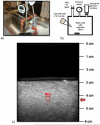Subharmonic aided pressure estimation for monitoring interstitial fluid pressure in tumours--in vitro and in vivo proof of concept
- PMID: 24856899
- PMCID: PMC4120866
- DOI: 10.1016/j.ultras.2014.04.022
Subharmonic aided pressure estimation for monitoring interstitial fluid pressure in tumours--in vitro and in vivo proof of concept
Abstract
The feasibility of using subharmonic aided pressure estimation (SHAPE) to noninvasively estimate interstitial fluid pressure (IFP) was studied. In vitro, radiofrequency signals, from 0.2 ml/l of Definity (Lantheus Medical Imaging, N Billerica, MA) were acquired within a water-tank with a Sonix RP ultrasound scanner (Analogic Ultrasound, Richmond, BC, Canada; fT/R=6.7/3.35 MHz and fT/R=10/5 MHz) and the subharmonic amplitudes of the signals were compared over 0-50 mmHg. In vivo, five swine with naturally occurring melanomas were studied. Subharmonic signals were acquired from tumours and surrounding tissue during infusion of Definity and compared to needle-based pressure measurements. Both in vitro and in vivo, an inverse linear relationship between hydrostatic pressure and subharmonic amplitude was observed with r(2)=0.63-0.95; p<0.05, maximum amplitude drop 11.36 dB at 10 MHz and -8 dB, and r(2) as high as 0.97; p<0.02 (10 MHz and -4/-8 dB most promising), respectively, indicating that SHAPE may be useful in monitoring IFP.
Keywords: Breast cancer; Contrast agents; Pressure estimation; Subharmonic signals; Ultrasound imaging.
Copyright © 2014 Elsevier B.V. All rights reserved.
Figures






Similar articles
-
Recent Experiences and Advances in Contrast-Enhanced Subharmonic Ultrasound.Biomed Res Int. 2015;2015:640397. doi: 10.1155/2015/640397. Epub 2015 May 18. Biomed Res Int. 2015. PMID: 26090430 Free PMC article. Review.
-
Subharmonic-Aided Pressure Estimation for Monitoring Interstitial Fluid Pressure in Tumors: Calibration and Treatment with Paclitaxel in Breast Cancer Xenografts.Ultrasound Med Biol. 2017 Jul;43(7):1401-1410. doi: 10.1016/j.ultrasmedbio.2017.02.011. Epub 2017 Apr 19. Ultrasound Med Biol. 2017. PMID: 28433436 Free PMC article.
-
Subharmonic contrast microbubble signals for noninvasive pressure estimation under static and dynamic flow conditions.Ultrason Imaging. 2011 Jul;33(3):153-64. doi: 10.1177/016173461103300301. Ultrason Imaging. 2011. PMID: 21842580 Free PMC article.
-
Investigation Into the Subharmonic Response of Three Contrast Agents in Static and Dynamic Flow Environments Using a Commercially Available Diagnostic Ultrasound Scanner.Ultrasound Med Biol. 2024 Nov;50(11):1731-1738. doi: 10.1016/j.ultrasmedbio.2024.07.015. Epub 2024 Aug 31. Ultrasound Med Biol. 2024. PMID: 39217026
-
The Effect of Mixing Iodinated Contrast Media and Ultrasound Contrast Agents on Subharmonic Signals.Ultrason Imaging. 2024 Mar;46(2):130-134. doi: 10.1177/01617346241227971. Epub 2024 Feb 6. Ultrason Imaging. 2024. PMID: 38318708
Cited by
-
Recent Experiences and Advances in Contrast-Enhanced Subharmonic Ultrasound.Biomed Res Int. 2015;2015:640397. doi: 10.1155/2015/640397. Epub 2015 May 18. Biomed Res Int. 2015. PMID: 26090430 Free PMC article. Review.
-
Subharmonic-Aided Pressure Estimation for Monitoring Interstitial Fluid Pressure in Tumors: Calibration and Treatment with Paclitaxel in Breast Cancer Xenografts.Ultrasound Med Biol. 2017 Jul;43(7):1401-1410. doi: 10.1016/j.ultrasmedbio.2017.02.011. Epub 2017 Apr 19. Ultrasound Med Biol. 2017. PMID: 28433436 Free PMC article.
-
Non-Invasive Intra-cardiac Pressure Measurements Using Subharmonic-Aided Pressure Estimation: Proof of Concept in Humans.Ultrasound Med Biol. 2017 Nov;43(11):2718-2724. doi: 10.1016/j.ultrasmedbio.2017.07.009. Epub 2017 Aug 12. Ultrasound Med Biol. 2017. PMID: 28807449 Free PMC article.
-
High and low frequency subharmonic imaging of angiogenesis in a murine breast cancer model.Ultrasonics. 2015 Sep;62:50-5. doi: 10.1016/j.ultras.2015.04.012. Epub 2015 May 5. Ultrasonics. 2015. PMID: 25979676 Free PMC article.
-
Three-Dimensional Subharmonic Aided Pressure Estimation for Assessing Arterial Plaques in a Rabbit Model.J Ultrasound Med. 2019 Jul;38(7):1865-1873. doi: 10.1002/jum.14884. Epub 2018 Dec 17. J Ultrasound Med. 2019. PMID: 30560581 Free PMC article.
References
-
- Guarneri V, Frassoldati A, Giovannelli S, Borghi F, Conte P. Primary systemic therapy for operable breast cancer: A review of clinical trials and perspectives. Cancer Letters. 2007;248:175–185. - PubMed
-
- Mauri D, Pavlidis N, Ioannidis JPA. Neoadjuvant versus adjuvant systemic treatment in breast cancer: a meta-analysis. Journal of the National Cancer Institute. 2005;97:188–194. - PubMed
-
- McMasters KM, Hunt KK. Neoadjuvant chemotherapy, locally advanced breast cancer, and quality of life. Journal of clinical oncology : official journal of the American Society of Clinical Oncology. 1999;17:441–444. - PubMed
-
- Curti BD, Urba WJ, Gregory Alvord W, Janik JE, Smith JW, Madara K, Longo DL. Interstitial Pressure of Subcutaneous Nodules in Melanoma and Lymphoma Patients: Changes during Treatment. Cancer Research. 1993;53:2204–2207. - PubMed
-
- Heldin CH, Rubin K, Pietras K, Ostman A. High interstitial fluid pressure - an obstacle in cancer therapy, Nature reviews. Cancer. 2004;4:806–813. - PubMed
Publication types
MeSH terms
Substances
Grants and funding
LinkOut - more resources
Full Text Sources
Other Literature Sources
Medical
Miscellaneous

